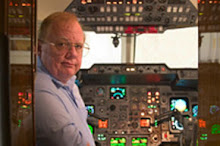By Vincent on Jun 15, 2010Your VOR receiver does not care for your heading…
ADF receivers are easy to understand. They measure the direction from where the signal from the station is coming. Then, if you turn right, the needle’s head will go left, and if you turn left, the needle goes right. Easy. But with a VOR receiver, even if you fly a 360, the needle won’t move. Not at all. Even the TO / FROM flag will not see any change.
Back basics: how VOR works?
Many pilots struggle with that and I think this is because the name TO / FROM flag is misleading. Going back to the basics is the best way to understand how VOR works and why they don’t care about the aircraft’s heading. The VOR ground station transmits two signals which can be compared to waves:
- The reference signal is the same in all directions
- The variable signal is different in different direction
North of the station, the reference and variable signals are synchronized. The top of both waves reach the receiver at the same time. East of the station, the top of the variable signal’s wave is delayed and reach the receiver a quarter of the cycle’s period later. By measuring the time difference between the reception time of both waves’s tops, the receiver can know it’s east of the station. South of the stations, the variable signaled is delayed by half a cycle, and so on.
Because the VOR receiver measures this difference in time – or, for engineers, in phase – they are completely independent from the aircraft’s heading. Whatever the heading flown, the received time difference is the same. What the CDI needle and the TO / FROM flag indicate are not direct reading from the receiver, but the difference between an arbitrary radial selected by the pilot and the measured one. Yes, this is the radial selected by turning the OBS knob.
What’s really driving the VOR TO / FROM indicator
Once the selected radial is defined, the VOR receiver splits the airspace in two sectors along a line going through the station, perpendicularly to the selected radial. The part that contains the selected radial is the FROM sector, the other half being the TO sector. Nothing to do with the aircraft’s heading, only its position relatively to the station and the selected radial.
Need an example? Let’s make it easy. The selected radial is 360, the line starting from the station and extending towards North. The perpendicular line is the one going from East to West. So the two sectors are North and South of the VOR. The one containing the selected radial is the one North of the VOR. This is the FROM sector. The part south of the VOR is the TO sector. Whatever aircraft heading, if it is located north of the VOR, the display will show a FROM flag. If the aircraft is in the FROM sector and flies a 360 degrees turn, it remains in the FROM sector. No flag change.
This sounds complicated? May be even scary? Does it remembers you of overheard stories of VOR being sometimes misleading? Yes, VOR can mislead you and a needle to the left can mean you have to turn to the right… but only if you don’t use it the correct way.
If you're new here, you may want to subscribe to my RSS feed. Have a look at my homebase for a good overview. Thanks for visiting!
Great post on how to use the VOR, but more interesting were the range radio navigation facilities I learned on!

